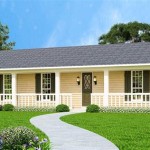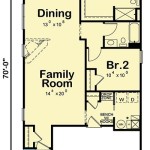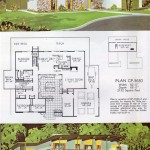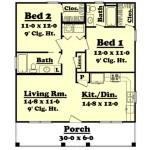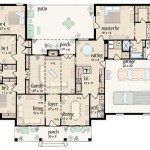Home Plans With Detached In-Law Suite: A Comprehensive Guide
The increasing desire for multi-generational living arrangements, coupled with the need for flexible housing options, has driven a surge in demand for home plans featuring detached in-law suites. These dwellings, also known as accessory dwelling units (ADUs), granny flats, or backyard cottages, offer a unique combination of privacy and proximity, catering to diverse family needs and lifestyles. This article delves into the intricacies of home plans with detached in-law suites, exploring their benefits, design considerations, regulatory aspects, and potential impact on property value.
A detached in-law suite is a self-contained living space located on the same property as the primary residence, but physically separated from it. This separation is a key defining characteristic, distinguishing it from attached apartments or additions integrated into the main house. The detached structure typically includes a bedroom, bathroom, living area, and kitchen or kitchenette, providing independent living facilities for the occupants.
Benefits of Detached In-Law Suites
The advantages of incorporating a detached in-law suite into a property are multifaceted, addressing various personal and financial considerations. One of the most prominent benefits is the provision of comfortable and private living space for aging parents or other family members. This arrangement allows for close familial support while maintaining individual autonomy and personal boundaries. This is often a more attractive option than assisted living facilities, permitting family members to remain connected and involved in each other's lives, fostering a sense of community within the family unit.
Financially, a detached in-law suite can present significant opportunities. It can serve as a rental unit, generating passive income to offset mortgage payments, property taxes, or other expenses. This is particularly attractive in areas with high rental demand or limited housing availability. Alternatively, the suite can accommodate adult children who are transitioning into independent living, providing a bridge between full dependency and complete self-sufficiency. This arrangement can help them save on rent while contributing to household expenses, benefitting both the parents and the young adults.
Beyond family and financial benefits, detached in-law suites can enhance property value and versatility. They can increase the overall square footage of the property, making it more appealing to potential buyers in the future. The added flexibility of the space makes it suitable for various uses over time, such as a home office, guest house, artist studio, or home gym. This adaptability ensures that the investment remains relevant and valuable regardless of changing needs and circumstances.
Key Design Considerations for Detached In-Law Suites
Designing a detached in-law suite requires careful planning to ensure functionality, comfort, and compliance with local regulations. The design should prioritize accessibility, particularly if the suite is intended for elderly or disabled occupants. This includes features such as ramp access, wider doorways, grab bars in bathrooms, and easy-to-reach appliances. Universal design principles should be incorporated to create a space that is usable by people of all ages and abilities.
Privacy is another crucial consideration. The placement of the detached suite on the property should minimize visual and acoustic intrusions from the main house and neighboring properties. Strategic landscaping, such as trees and shrubs, can create a natural buffer, enhancing privacy and creating a sense of seclusion. The orientation of the suite should also be considered to maximize natural light and views while minimizing exposure to harsh sunlight or prevailing winds.
The size and layout of the suite should be tailored to the anticipated needs of the occupants. A well-designed suite will include a comfortable living area, a functional kitchen or kitchenette, a private bedroom, and a accessible bathroom. Adequate storage space is essential to minimize clutter and maximize livability. The design should also consider the potential for future modifications or expansions, allowing the suite to adapt to changing needs over time.
Energy efficiency is a critical aspect of sustainable design. Incorporating energy-efficient windows, insulation, and appliances can significantly reduce energy consumption and utility costs. Solar panels can provide a renewable energy source, further reducing the environmental impact. Water-saving fixtures, such as low-flow toilets and showerheads, can conserve water and lower water bills. These sustainable design features not only benefit the environment but also enhance the long-term value and appeal of the property.
The architectural style of the detached in-law suite should complement the existing house, creating a cohesive and harmonious aesthetic. The materials, colors, and detailing should be consistent with the overall architectural style of the property, ensuring that the suite blends seamlessly into the landscape. However, the suite can also incorporate unique design elements to create a distinct identity, reflecting the personality and preferences of the occupants.
Navigating Regulatory and Legal Aspects
Constructing a detached in-law suite often involves navigating a complex web of regulatory and legal requirements. Zoning regulations, building codes, and homeowners association rules can all impact the feasibility and design of the project. It is essential to thoroughly research local regulations and obtain the necessary permits before commencing any construction work. Failure to comply with these regulations can result in costly fines, delays, or even demolition orders.
Zoning regulations typically dictate the permissible size, location, and use of accessory dwelling units. Some jurisdictions may restrict the size of the suite to a percentage of the main house's square footage or limit the number of occupants. Setback requirements, height restrictions, and parking regulations can also influence the design and placement of the suite. It is crucial to understand these regulations and ensure that the proposed design complies with all applicable requirements.
Building codes establish minimum standards for safety, health, and structural integrity. These codes cover various aspects of construction, including foundations, framing, electrical wiring, plumbing, and fire safety. The detached in-law suite must meet all applicable building code requirements to ensure the safety and well-being of the occupants. It is advisable to hire a qualified architect or contractor who is familiar with local building codes and can ensure compliance throughout the construction process.
Homeowners association (HOA) rules can also restrict or prohibit the construction of detached in-law suites. Some HOAs may have covenants that limit the number of dwelling units on a property or impose restrictions on the appearance and use of accessory structures. It is essential to review the HOA rules and obtain approval before commencing any construction work. Failure to comply with HOA rules can result in fines or legal action.
Legal considerations also extend to rental agreements if the in-law suite is to be rented out. Landlord-tenant laws vary by jurisdiction, and it's crucial to understand the rights and responsibilities of both the landlord and the tenant. A well-drafted lease agreement should outline the terms of the tenancy, including rent, security deposit, utilities, maintenance, and termination clauses. Consulting with a real estate attorney is recommended to ensure compliance with all applicable laws and regulations.
The specific requirement for impact fees also varies depending on local jurisdiction. Impact fees are charges levied by local governments to offset the costs of providing public services, such as water,sewer, transportation, and schools, to new development. The implementation and amount of such fees vary, therefore researching them beforehand is crucial. These fees can significantly add to the total cost of the project.

Homes With Mother In Law Suites

House Plans With In Law Suites Houseplans Blog Com

In Law Suite Plans Give Mom Space And Keep Yours The House Designers

Country House Plan With 4 Bedrooms And 3 5 Baths 4427

Plan 65862 Tuscan Style House Floor Plans With 2091 Sq Ft 3 Be

Exclusive 4 Bed House Plan With Detached In Law Suite 93109el Architectural Designs Plans

One Story With In Law Suite Plan 2286

House Plans With In Law Suites Houseplans Blog Com

Arts And Crafts Country Home With 5 Bedrms 2473 Sq Ft Plan 108 1692

So I Have A Project Where Am Designing Main House And An Attached Mother In Law Suite The Is Guest Plans Family

